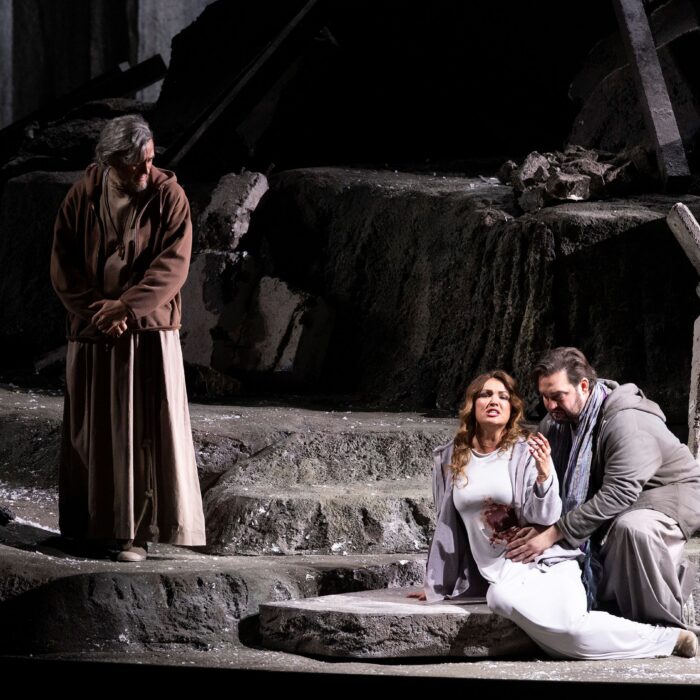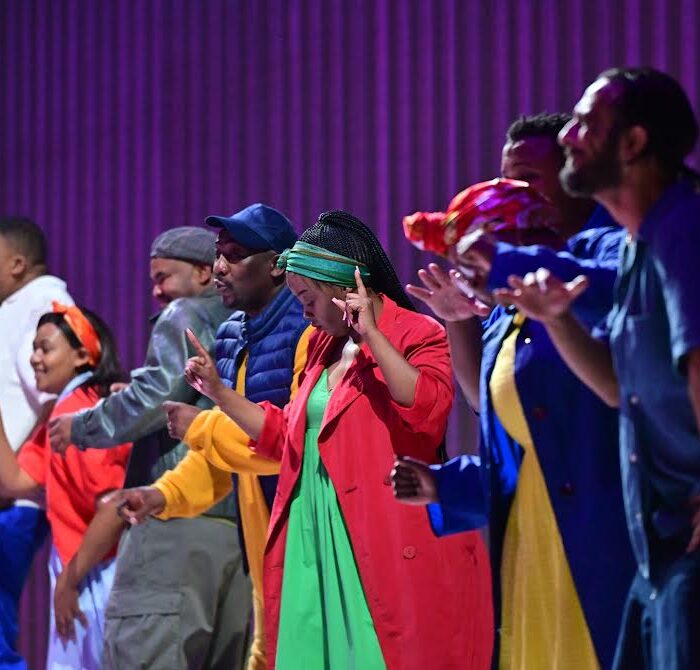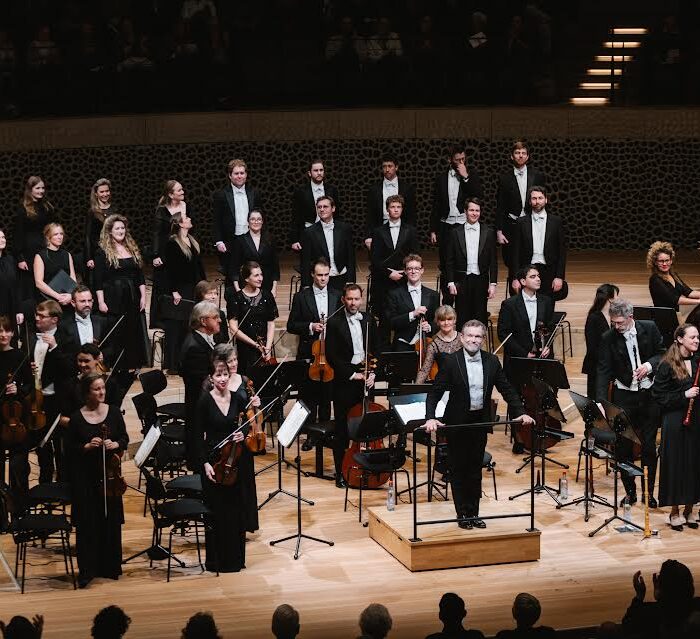
Glyndebourne 2024 Review: La Traviata
By Mike Hardy(Photo: Richard Hubert Smith)
“’La traviata’ last night a failure. Was the fault mine or the singers? Time will tell.” So wrote Giuseppe Verdi in a letter the day after the premiere performance in Venice in 1853. Fast forward to 2024, in the week of his Birthday, to Glyndebourne’s Tom Cairns 2014 revival production; and Verdi would probably have written the only reason it WASN’T a failure, WAS definitely down to the singers.
For whatever it was, Cairns, or revival director Laura Attridge and her assistants, were striving to achieve with this production mostly rendered impotent any attempts by the principals to portray any convincing emotion or connection. I found the whole staging and direction to be a poor imitation of Richard Eyre’s far superior work, now 30 years old. Indeed, the opening of the acts, especially the first and last, use the same technique of isolating Violetta in her bed, accentuated by suitable spot lighting, behind a gossamer-like curtain. But that is where any comparisons stop.
Awkward direction among minimalist, replicated sets served to render the performers depictions of anguish, jealousy, anger and passion as mere melodramatic, hammed up histrionics. Violetta never once convinced me she loved Alfredo, and he in turn never really rose above the comedic, wide-eyed, buffoonish persona he adopted. In fact, both characters frequently resembled silent movie actors, embarking on a series of exaggerated emotional displays. Even in the final act, normally a truly heart-rending tear-jerker; neither seemed remotely interested in anything other than their own misery, almost indifferent to each other’s presence, entrenched in their own, personal misfortunes.
It didn’t help that the stage setting, a simple curved abstract wall with an offset opening served as the backdrop for all four acts, removing any chance of presenting a credible telling of story. As did the fact that set and costume designer Hildegard Bechtler seemed uncertain as to what period she wanted to create. The already described, minimalist backdrop suggested art deco, as did the 1930’s style costume of the ladies in the first act. Alas, the THIRD act soiree ensemble appears to be a weird confection of 1960’s/70’s and contemporary. The ‘Matadors’ appeared to have dropped in from a local ‘Stag’ night. Even the dancing troupe of ‘gypsies’ seemed confused and bored, dressed as they were as cheap nightclub lap-dancers who performed their routine perfunctorily.
Opera is so frequently and notoriously devoid of credibility in its tales, but with the right direction it can at least do justice to the libretto and plot. For me, that didn’t happen here. At the cessation of the opera, where Violetta expires, the performers merely traipse off stage sombrely, in some obviously convoluted symbolism which went completely over my head.
I understand many people go to the opera for many reasons; the whole experience, the drama, the visual splendour, (where it exists), the costumes etc…for me, as I am wont of saying, it is all about the music and the singing. And in THAT respect, at least, I, (as would VERDI), found some solace.
Illuminating Cast
Italian soprano Elisa Verzier, here in her debut, is patently endowed with great gifts. Her, frequently, voluminous yet beautiful voice most impressive, yet capable of descending into sweetness with its sotto-voce. She also displayed a most impressive and accurate coloratura with its neat trills and arpeggios. Given that she is Italian, I found it curious that she frequently appeared to have enunciation issues in the first act where I occasionally struggled to find definition in her diction. I found her at her most engaging and convincing, however, in her interactions with Germont senior in the second act, where she delivered a magnificent “Dite Alla Giovine.” Her final aria in Act four, “Addio, del passato,” was mesmerizing. Slight of build, she also cuts an impressive portrayal of a wretched and ill-stricken Violetta, having an almost tangible fragility and vulnerability.
Her lover, Alfredo, is performed by Italian tenor Matteo Desole. He possesses a wonderful, bright, ringing tenor voice which reminded me, on occasion, of Joseph Calleja. He sings with a wonderful line and has a clean, crisp top. His “Libiamo” was suitably impactive and his duet with Violetta, “Un dì, felice, eterea,” was quite wonderful, particularly the passage beginning with the line “Di quell’amor ch’è palpito,” where his fine legato shone.
His second act aria, “De’ miei bollenti spiriti,” was particularly accomplished, with robustness and fine clarity. As is the case with Verzier, Desole can clearly act but I felt that the stage direction and “script” impeded both their abilities to convey any true emotion or sentiment.
More Cast Highlights
Christian Federici completes the trio of Italian principals in this performance. As Alfredo’s father, Giorgio, Federici is as fine a baritone in this role as I have heard. Exquisitely rich, clarion, and beautifully orotund, he possesses a remarkable instrument. Not only did he probably win the pip to the post in the vocal stakes, but he was also by far the most convincing in character. He presents as an austere, business-like authoritarian, but melts into compassion in his interactions with Violetta, his voice displaying evocative phrasing and color. I first heard Federici at the Royal Opera House as Angelotti in “Tosca,” where I opined I would like to hear more of him. I am delighted to have been afforded the opportunity to do so here.
Likewise, the smaller roles were sung with fine artistic proficiency; baritone Alexander Vassiliev suitably sonorous as Doctor Grenvil; Adam Marsden, rich in tone and wonderfully rancorous as the Baron and a stellar performance from Esme Bronwen-Smith as Violetta’s dutiful friend, Flora, a fine soprano who was most enchanting in the Act two soiree. Georgia Mae Ellis as Violetta’s maid, Annina, performs well vocally, but whose performance is diminished by virtue of stage direction that requires her to be perpetually in attendance of her Mistress, in such a concerned and attentive manner as one would be for a small child near an open fire.
The Glyndebourne Chorus were as impressive and resonant as I have always found them to be, elevating the crowd scenes and soirees with compelling unity.
Likewise, The Glyndebourne Sinfonia produced exquisite sounds, especially the sections that required evocative and gentle strings. The prelude and the commencement of the final act, especially, were quite wonderful.
In the pit, for the most part, I found conductor Adam Hickox to be in fine command of his orchestra, alas; he appeared to be thrown out a tad when the audience applauded at the end of a particular sequence, which appeared to disturb his intent, so much so that on at least a further one occasion, when the audience began to applaud, he commanded the orchestra to proceed and cut the acclamations. Which is a pity because that, in turn, appeared to subdue the audience who subsequently failed to applaud a number of arias, (notably Verzier’s “Addio, del passato”) where they otherwise most certainly would have done so.
Lighting director Peter Mumford’s talents were restricted to simply requiring old fashioned spotlights for the singers. Quite possibly, not least, because the already described minimalist, persistent stage set would not have been much enhanced by illumination.
Overall, vocally resplendent, musically sound, but lacking in conviction and devoid of any genuine sentiment or impassionedness, instead, relying on exaggerated or hammy motifs to tell the tale.
Categories
Reviews


